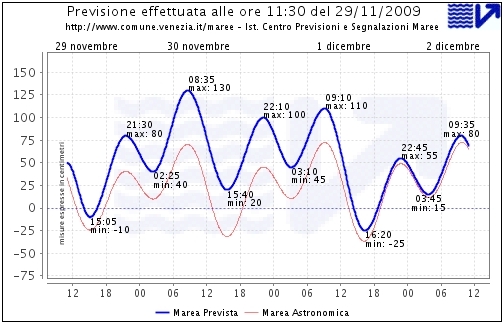 Tomorrow morning Venice will sink under a maximum tide predicted to reach 1.30 meters above average sea level. The event will occur at 8.35AM, a time when Venetian residents are in the streets trying to bring children to school or to reach their workplace. You can see the predicted evolution of the tide in the graph below, where the red curve shows the time variation of the season's average, and the blue one the actual prediction for tomorrow. The peak of 130 cm above average sea level is predicted to occur at 8.35AM -which is 2.35AM in New York, or 5.35PM in Tokyo.
Tomorrow morning Venice will sink under a maximum tide predicted to reach 1.30 meters above average sea level. The event will occur at 8.35AM, a time when Venetian residents are in the streets trying to bring children to school or to reach their workplace. You can see the predicted evolution of the tide in the graph below, where the red curve shows the time variation of the season's average, and the blue one the actual prediction for tomorrow. The peak of 130 cm above average sea level is predicted to occur at 8.35AM -which is 2.35AM in New York, or 5.35PM in Tokyo.
The vast majority of the walking ground in Venice is expected to be flooded with anything from a few inches to two feet of sea water. My memory immediately brings me back to December 1st last year, when the day before the tide was exactly predicted to reach +1.30 meters in the morning -a striking resemblance to tomorrow's forecast- but then suddenly increased to +1.56 meters above sea level, making it the fourth strongest "acqua alta" of modern times. On December 1st, 2008 the damage was significant, although tourists apparently liked the uncommon event, and a well-organized nutcase even used the event to do water skiing in Piazza San Marco.
 A system of mobile barriers stopping the water flow inside Venice lagoon, called "Mose", has been in construction for a few years. It is designed to mitigate the effect of events of this kind, but it is unfortunately not yet in operation. The Mose barriers are huge tanks which usually rest on the seabed filled with water; when they need to be deployed, compressed air is forced inside, blowing away the water and rising them up, blocking most of the water flow inside the lagoon from the Adriatic Sea.
A system of mobile barriers stopping the water flow inside Venice lagoon, called "Mose", has been in construction for a few years. It is designed to mitigate the effect of events of this kind, but it is unfortunately not yet in operation. The Mose barriers are huge tanks which usually rest on the seabed filled with water; when they need to be deployed, compressed air is forced inside, blowing away the water and rising them up, blocking most of the water flow inside the lagoon from the Adriatic Sea.If you are nosy enough to watch the event in real time, you may want to have a look at the live webcams scattered around Venice. Below is a short list of links (but you are sure to find more with a simple google search).
Webcam 1
Webcam 2
Webcam 3
Webcam 4
Here instead you can get real-time forecasts of the sea level, to check the evolution of the event.




Comments